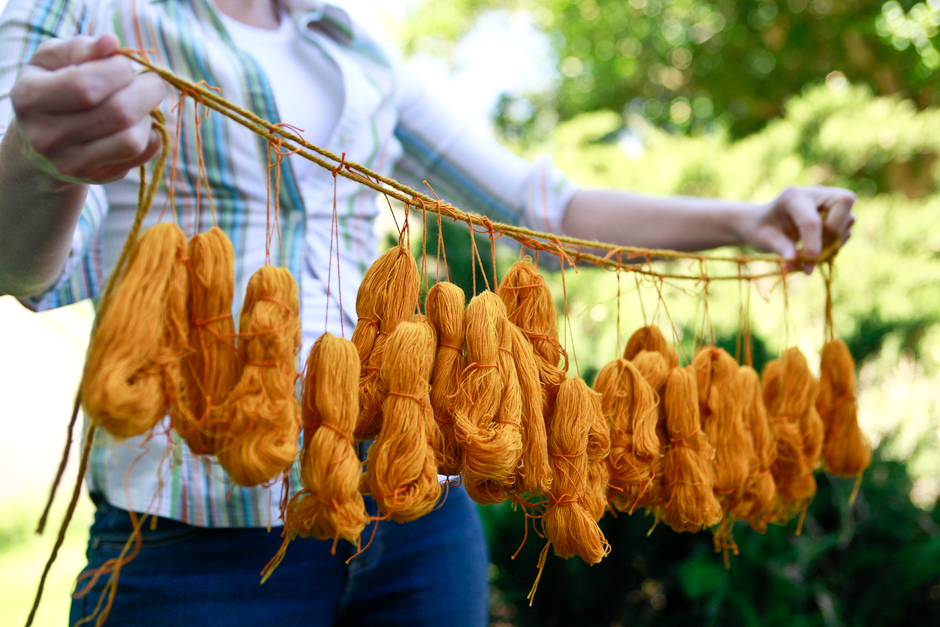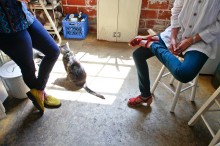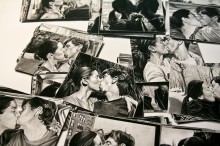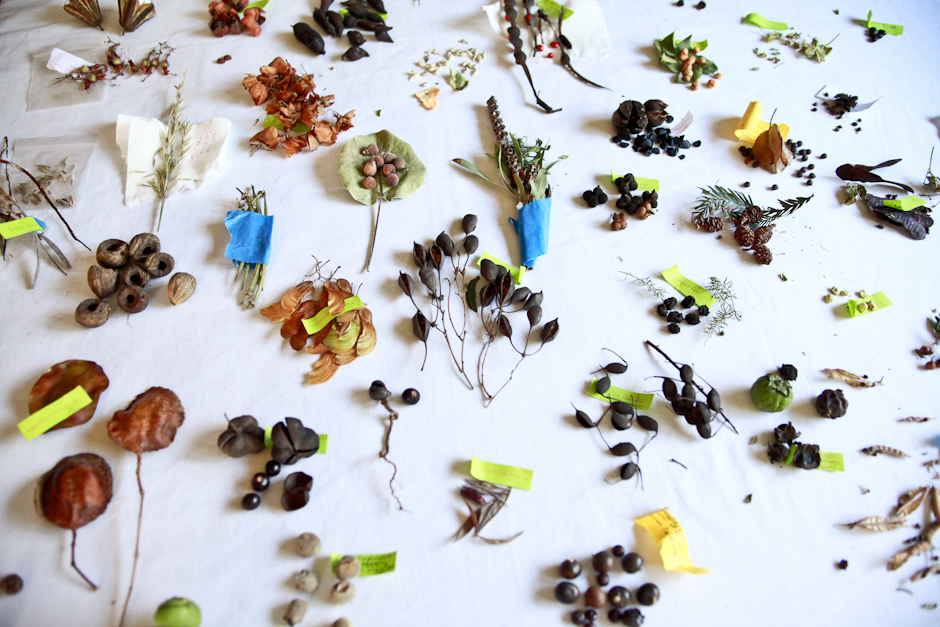
Esther Traugot
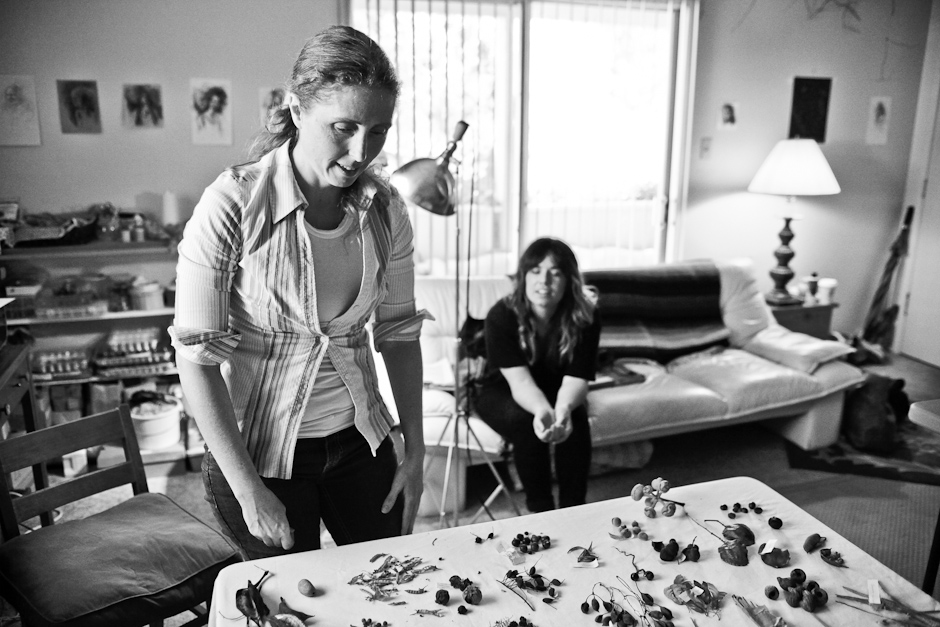
Sometimes I am unprepared for how intimate studio visits can be and I find myself squirming a bit because all of a sudden I’m in a stranger’s home, sitting on their couch or at their kitchen table, amidst the distinct smell of their home, surrounded by their family photos, the dirty dishes in their sink, and the comings and goings of their dogs, kids, partners, and roommates… and I think to myself, “This is weird. Wonderful. But weird.”
I had that feeling when we first arrived at Esther’s home studio, like I was entering into someone’s very personal, private corner of the world. Esther lives, works, and raises her children out of a small apartment in Sebastopol, and because her space is very limited she uses the living room as her studio, but it still functions as a family room, too. Over the years, we have visited many artists that work out of their homes, often converting rooms or garages or basements into studios, or occasionally, like Esther, they simply have to ask their space to do double duty. And to me, this says a lot about their commitment, their resourcefulness, and their identity as artists.
Esther works within the mediums of painting, sculpture and installation to investigate our personal connections with the natural world. In much of her work, she covers objects of nature with crocheted threads, always in an ochre gold color, in an attempt to “prop up” or “put back” what has been abandoned or damaged. These crocheted wrappings are meticulous interventions… like a bandage or armor … lending protection and preciousness to these objects, but that also express an element of control.
As I sat on her couch, in the middle of her home, talking to her about her work, and as she pulled out beautiful seed pods, dead insects, twigs, and eggs that she has found and collected and laid them out on her table for us to examine, I couldn’t help thinking how small, how cozy, how dear her reality is. Seeing these tiny natural forms up close was a moving experience— the delicate fuzz on a bee’s body, the smooth, polished curve of an egg’s shell, the iridescent gleam of a butterfly’s wing… it all seemed so perfect, so humble and broken, so delicate and diminutive, and yet so frightfully grand, too. I was dazzled. Esther says, “I collect little pieces of nature that I find for their shape and color, or particular uniqueness. In wrapping them I find a correlation to the caring and intention of making them important and worthy of protection in some way…”
To be honest, Esther’s work makes my heart break a little— there is so much tenderness in it. It elicits memories of childhood, of how I played out in the woods alone with the family dog in tow, wandering about observing and gathering, letting my imagination breathe itty bitty secret lives into each flower, stone, or beetle I encountered…setting my world ablaze with wonder one tiny little finding at a time.
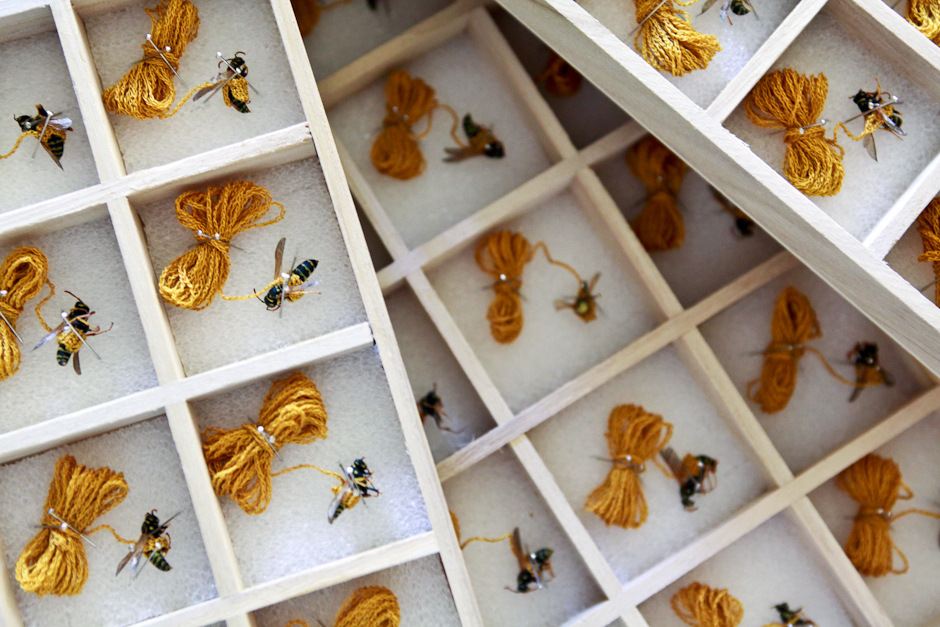
How would you describe your subject matter or the content of your work?
I crochet, wrap skins around natural forms with gold-colored threads, exploring the instinct to nurture and protect them. I am interested in the ways that the stitching accentuates their forms as well as how they create casings that make sense to how the objects might need to be nurtured.
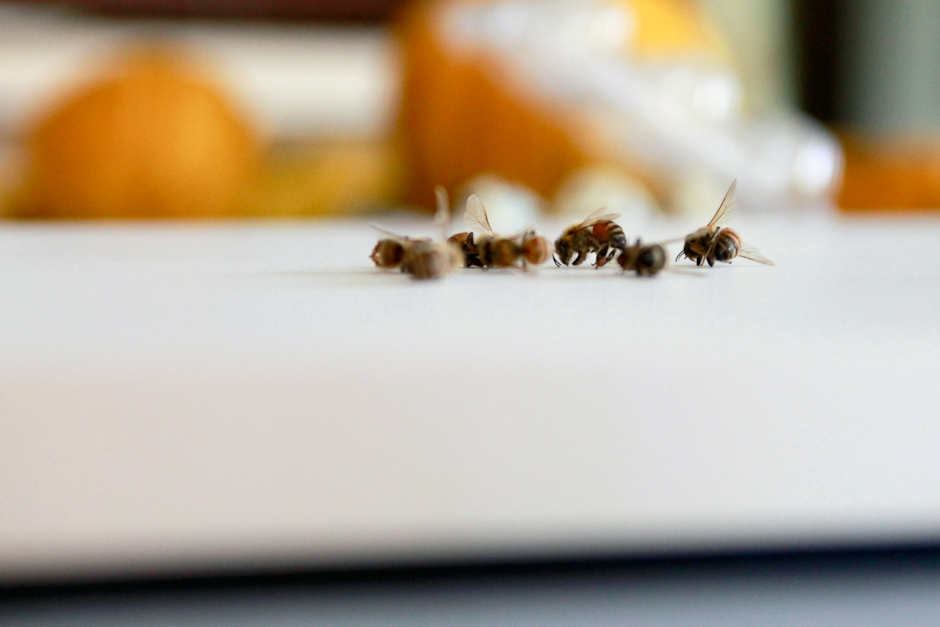



What mediums do you work with?
In my process, I use drawing, photography, found natural objects, fabric dyes, yarns and threads, construction materials.
Your crocheted thread coverings in your installation work is always the same almost gold/ochre color. Why?
I have settled on this color for now because of its vibrancy, warmth, and association with gold in gilding. It speaks to making them more precious.
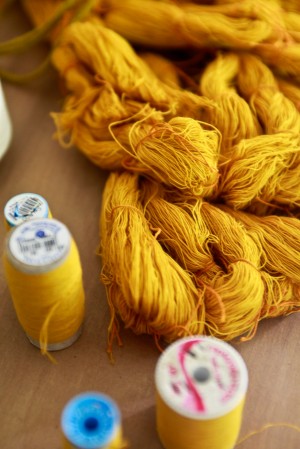
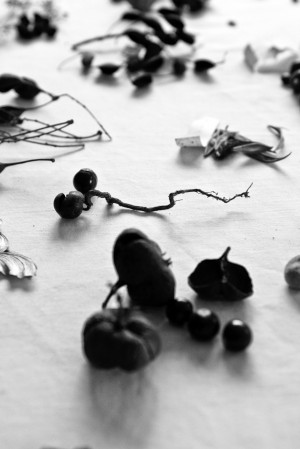
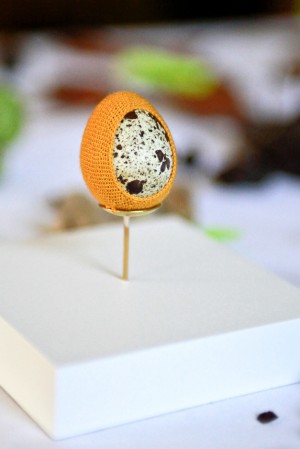
I read that you grew up in a rural landscape, amongst a community that was in pursuit of utopian ideals— how has this influenced your work, both conceptually and aesthetically?
It instilled in me a sense of caring and responsibility for our natural environment. My parents were part of the Back to The Land movement in the 70s. From the largest mountain to the smallest bug, they are all important. As a child, I developed a particular way of relating to the world around me, where I wouldn’t step on an ice-puddle, or newly fallen snow, so I wouldn’t disturb what was there. I wouldn’t step on ants, or kill a wasp that found it’s way into my house, but catch it in a jar to take outside. My father was a vegetable farmer and I would help him in the greenhouse and in the fields planting, and in driving the horses and cart. I am still interested in agriculture today, and am drawn to being in nature. I notice, even in urban areas, the plants and shape of land, how we have constructed living spaces within what is still nature. I collect little pieces of nature that I find for their shape and color, or particular uniqueness. In wrapping them I find a correlation to the caring and intention of making them important and worthy of protection in some way, as well as their sculptural and formal qualities. I think about the idea of nature: sentimental vs. commodity, about what it means to nurture and protect, and when that protection becomes control.
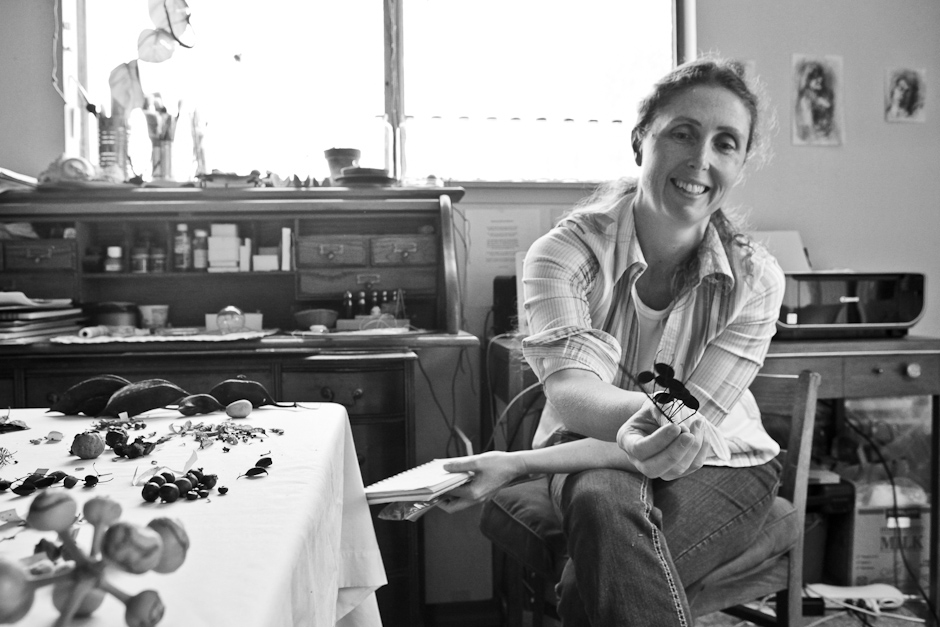
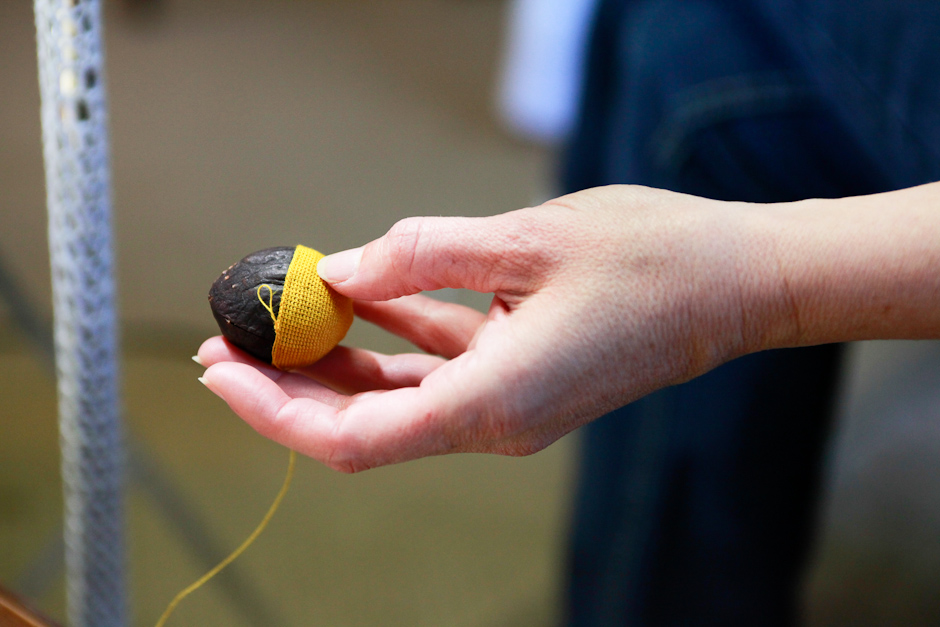
What are you presently inspired by— are there particular things you are reading, listening to or looking at to fuel your work?
I find that I don’t have to look far to find good material to read and work with. I find it on my doorstep, at the farmers’ market, in the food I eat, the air I breathe. I guess I look at my direct life and what I find in it that gets me to think about nature and the modern world. I am reading Michael Pollen’s book, The Botany of Desire. I look at seed catalogues, and the National Heirloom Exposition.
What does having a physical space to make art in mean for your process, and how do you make your space work for you?
I don’t have a separate studio. I work from my living room at home. I have a family. I live and work around my art. Using yarns and crocheting lends itself well to this environment, vs. painting materials. I can work for any length of time and put it down at a moment’s notice. I have also brought crochet work with me to my kids’ doctor appointments, lessons, etc.

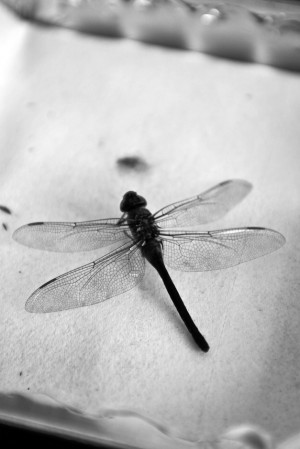
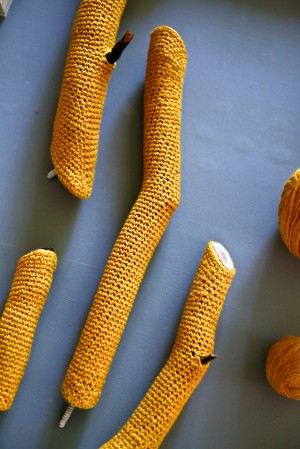
Is there something you are currently working on, or are excited about starting that you can tell us about?
I have three projects in focus:
The Arboretum Seed project — I am currently starting a large seed project for an exhibit at Cal State Fullerton, where I collect seeds from their campus arboretum, where they focus on conservation of special, heirloom, native varieties from all over the world. I will be researching the seed varieties and special qualities of their plants.
I am very excited about my next big project working with dead honeybees. I will be negotiating with and gathering from local apiaries a group of deceased bees and wrapping each in their own little blanket. This piece is promised for an exhibition, called Extinction, in Sao Paulo, Brazil in early 2015.
Another is about my avocado pits. Over the past couple years I have saved and dried about 200 avocado pits that I will be crocheting wrappings for. My intention is to make a large quantity of them to display next to each other, perhaps in one very long row, to articulate variation in size and shape in a single variety.

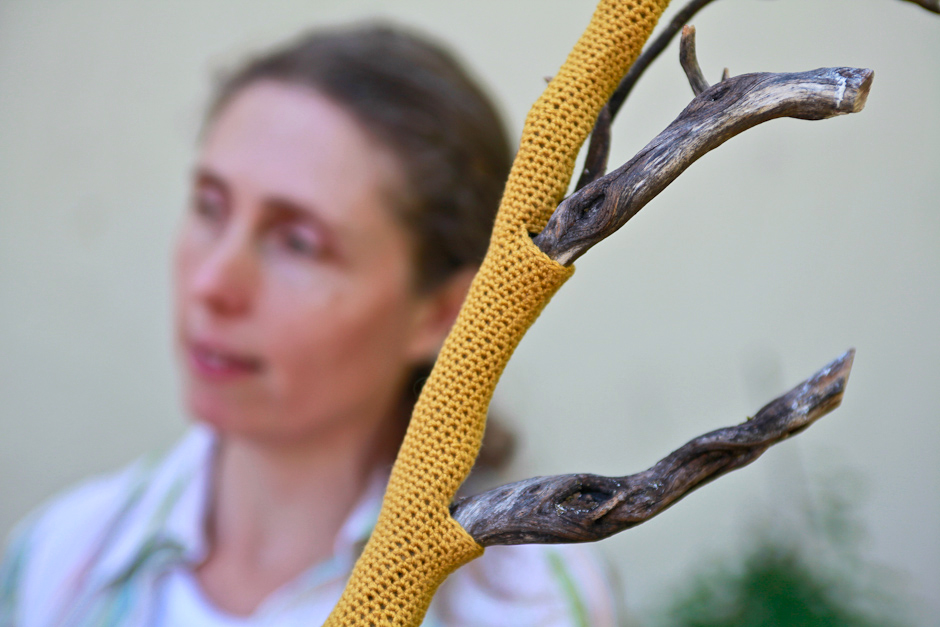
Do you see your work as relating to any current movement or direction in visual art or culture? Which other artists might your work be in conversation with?
I think my work relates to and is in conversation with Land and Environmental art and Feminism.
And more specifically, these artists:
Annette Messager’s knitted birds.
Liza Lou’s beadwork.
Wolfgang Laib pollen collecting.
And, the Crochet Coral Reef Project.
How do you navigate the art world?
I am currently on the path of the gallery exhibition. I choose it, but I think it chose me as well, because most of my exhibitions have come from offers and word of mouth referrals. I find that by following up on, negotiating with venues and talking about my work all lead to more opportunities and experience. Plus, I find a little bit of just allowing the alchemy to happen brings amazing opportunities that I hadn’t imagined for myself. I used to be more stressed about how I was going to make it all work, which direction I would go, etc.
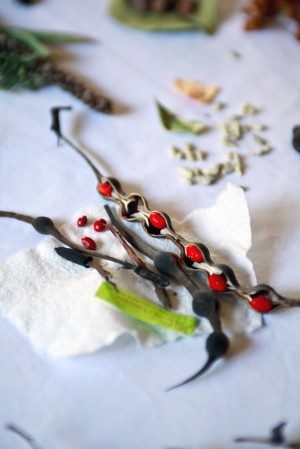
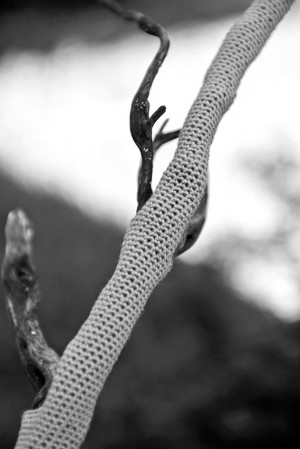
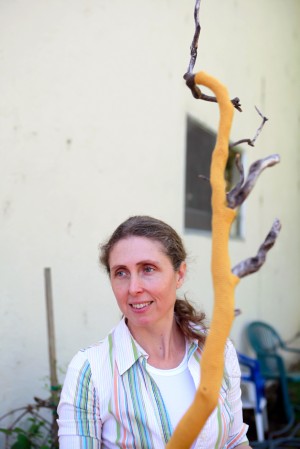
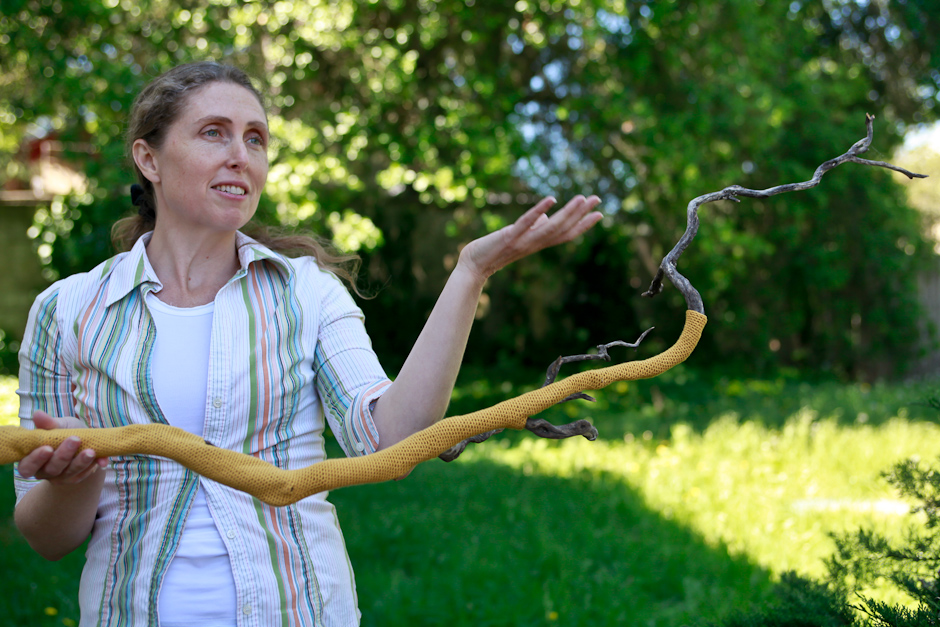
Do you have a motto?
Probably it would be that I am interested in a “contemporary naturalism.” I don’t think that the conversation around “nature” is outdated. Now more than ever the subject of nature is part of our social dialogue, with global warming, conservation, extinction, etc. In art, it is no less worthy, only evolving.
Are you involved in any upcoming shows or events? Where and when?
This Summer my work will be in “Ego/Eco, Environmental Art for Collective Consciousness”, in the Begovitch Gallery, at Cal State Fullerton, L.A.. The show runs from August 31- October 2.
This fall I am part of a show, “Making Special; Transforming the ordinary”, in the Robert F. Agrella Gallery at Santa Rosa Junior College, November 13- December 12.
Winter 2015, group show titled Ethics, Excess, and Extinction, Museu Brasileiro da Escultura, Sao Paulo, Brazil | 2015.
To see more of Esther’s work:
Chandra Cerrito Gallery, 480 23rd St., Oakland, CA
www.esthertraugot.com
